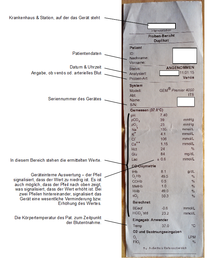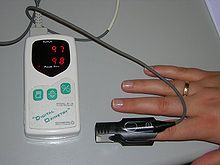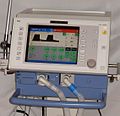Hypoventilation
| Classification according to ICD-10 | |
|---|---|
| E66.2 | Excessive obesity with alveolar hypoventilation |
| G47.3 | Sleep apnea |
| R06 | Breathing disorders |
| ICD-10 online (WHO version 2019) | |
With hypoventilation is called an inadequate gas exchange of the organism breathing that may be too superficial and / or too slow. This leads to a decrease in the oxygen content in the blood and an increase in carbon dioxide ( hypercapnia ) with respiratory acidosis . The changes can be potentially life threatening.
Blood gas analysis is used for diagnosis, or pulse oximetry or transcutaneous carbon dioxide partial pressure measurement (pCO₂) is used for continuous and non-invasive monitoring .
causes
- Weakness of the respiratory muscles
- obstructive pulmonary dysfunction ( bronchial asthma , COPD , special form of obstructive sleep apnea syndrome )
- restrictive pulmonary dysfunction (e.g. loss of lung tissue, restricted mobility of the chest , scoliosis , funnel chest )
- Disturbance of the central nervous system of breathing
- medically through opioids or narcotics
- organic in central sleep apnea syndrome in the context of a weak heart or obesity ( obesity hypoventilation syndrome )
therapy
With chronic pulmonary dysfunction (e.g. COPD), the body can adapt to the changed conditions to a certain extent. They get used to the reduced oxygen content of the blood . The changes in the acid-base balance caused by the increased carbon dioxide are compensated for by the increased excretion of acids via the kidneys . Nevertheless, the underlying disease should be treated optimally and the cause (e.g. smoking ) eliminated.
If hypoventilation occurs suddenly, as is often the case with short anesthesia, for example as part of a gastroscopy , a critical drop in blood oxygen can be prevented by administering oxygen. The prerequisite is that breathing is basically still working. If this measure is not sufficient, the gas exchange can initially be guaranteed by means of mouth-to-mouth ventilation or mask ventilation . If the problem persists, this is done with machine support as part of non-invasive mask ventilation or invasive ventilation after intubation .
The often unnoticed respiratory regulation disorders during sleep (sleep apnea syndrome) represent a special form. After treatment of an underlying underlying disease (poorly controlled high blood pressure , heart failure , snoring ), non-invasive mask ventilation is adapted in the sleep laboratory .
See also
Individual evidence
- ↑ a b c d e f P. Marino: The ICU book . 4th edition. Urban & Fischer, Munich / Jena 2008, ISBN 978-3-437-23161-2 .
- ↑ a b S3 guideline for non-restful sleep / sleep disorders of the German Society for Sleep Research and Sleep Medicine (DGSM). In: AWMF online (as of 2009).





